Do interjections have 7 grammar rules in English?

This is the second and final chapter about Interjections. To complete this reader, read each chapter carefully and then unlock and complete our materials to check your understanding.
– Review the key features about interjections and their three types: cognitive, emotive and volitive
– Discuss the seven key grammar rules of interjections
– Complete the Chapter 1-2 Worksheets to check progress and improve English proficiency
Chapter 2

In this second and final chapter on the study of interjections as a word type in English, we first briefly review what was discussed in Chapter 1 before exploring in detail the seven grammar rules that make for their accurate use. Before continuing, what do you remember from our first chapter? What makes interjections unique, and can you think of any examples like ‘yay’ or ‘yikes’?
Interjections Review
- Interjections describe feelings and emotions rather than ideas or concepts.
- There are three types of interjection: cognitive (for feelings related to knowledge), emotive (for general emotions) and volitive (for commands and requests).
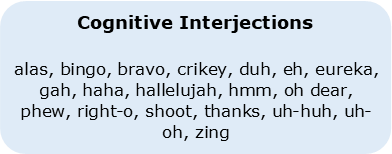
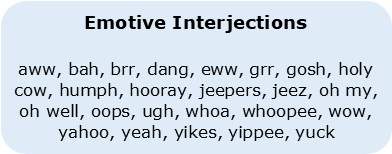

- Interjections require a knowledge of the surrounding context in order to understand the full meaning of the expression.
- It is not possible to modify or inflect interjections, and they do not add to the grammar of an expression either.
Rule 1: It’s OK to use interjections alone
The first rule to remember is that interjections may form grammatical sentences (ending with a full stop, exclamation or question mark) when used alone:


Rule 2: Understand their flexible distribution
Secondly, some interjections may be placed at various points within a sentence, usually where one phrase function ends (subject, object, etc.) and another begins. As the following examples show however, some placements sound better than others to native speakers of English
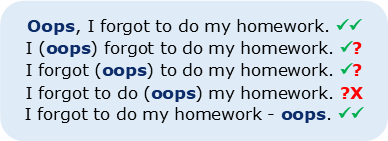
Rule 3: Remember to punctuate correctly
As the previous examples also demonstrate, it’s important to punctuate interjections appropriately. There are four instructions that can be followed here to ensure accurate use:
i) If the interjection forms a sentence alone, follow it with a full stop, question or exclamation mark.
ii) If the interjection comes at the start of a sentence, follow it with a comma or a hyphen.
iii) If the interjection appears within a sentence, surround it with commas, brackets or hyphens.
iv) If the interjection comes at the end of a sentence, precede it with a comma or a hyphen.



Rule 4: Use exclamation marks to show emphasis
While question marks (?) are used to indicate a query or uncertainty, exclamation marks (!) may also be used with interjections to show emphasis. The word ‘wow’ demonstrates less surprise, for example, than the punctuated ‘wow!’. Similarly, the querying ‘wow?’ (meaning ‘should I be surprised?’) can also be written with both punctuation marks, as in ‘wow!?’. Using both marks together in this way would demonstrate a simultaneous combination of both surprise and confusion.
Rule 5: Interjections can have multiple collocations
Another important rule to remember is that not all interjections are only one word long. Some interjections may also collocate (combine) with other words. As the tables below demonstrate, the addition of these collocations may express the same emotion as the original interjection or they may alter its meaning significantly:
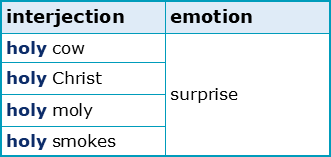
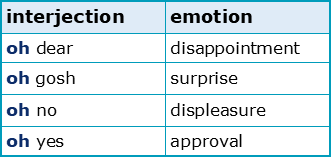
Rule 6: Interjections can have multiple meanings
As the next table shows, even single-word interjections such as ‘ah’ may have multiple meanings depending on the expression to which they refer:

Rule 7: Avoid formal contexts
Finally, one rule that’s important for university students is that interjections should never be used in highly formal academic writing. Academic language is famously objective, scientific, unambiguous and direct, and interjections such as ‘boo’ or ‘eek’ simply are not. Emotive words such as these are inappropriate in academic discourse and would lower your marks for an assignment if included. Use them instead when communicating with your friends, particularly informally such as when texting online.
Very well done on completing this short reader on interjections.
Downloadables
Once you’ve completed both chapters in this short reader about Interjections, you might then wish to download our Chapter Worksheets to check your progress or print for your students. These professional PDF worksheets can be easily accessed for only a few Academic Marks.
Chapter 1 explores the topic: Are interjections appropriate in academic writing? Our Chapter 1 Worksheet (containing guidance, activities and answer keys) can be accessed here at the click of a button.
Chapter 2 explores the topic: Do interjections have 7 grammar rules in English? Our Chapter 2 Worksheet (containing guidance, activities and answer keys) can be accessed here at the click of a button.
To save yourself 1 Marks, click on the button below to gain unlimited access to all of our Interjections Chapter Worksheets. This All-in-1 Pack includes every chapter, activity and answer key related to this topic in one handy and professional PDF.
Collect Academic Marks
-
100 Marks for joining
-
25 Marks for daily e-learning
-
100-200 for feedback/testimonials
-
100-500 for referring your colleages/friends